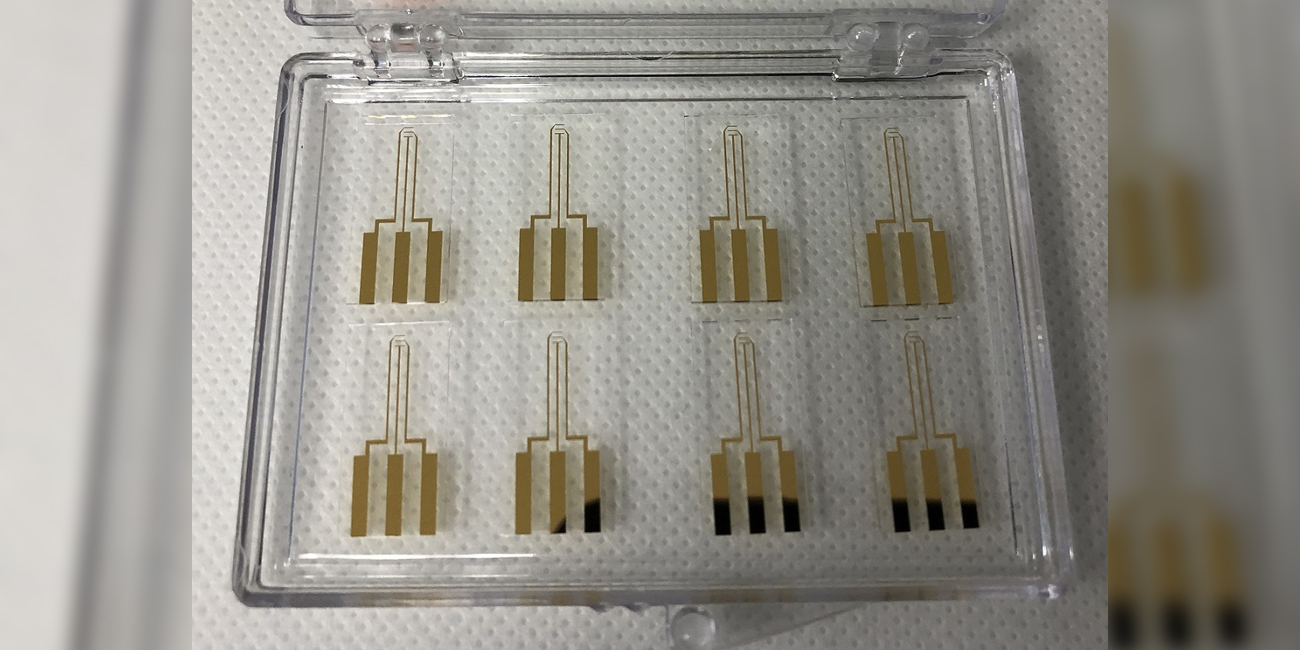Ultrananaotech, ULTRANANOTECH
Advancing Sensing Technologies: Exploring the World of Patterned Electrodes
Patterned electrodes refer to a type of electrode design used in various applications, especially in electronics and electrochemical devices. These electrodes are designed with specific patterns or shapes to enhance their performance, functionality, or to tailor their interactions with the surrounding environment. They can be made from a wide range of materials, such as metals, metal oxides, conductive polymers, or carbon-based materials like graphene.
Types of Patterned Electrodes
Patterned electrodes come in various forms, each tailored to specific applications and requirements. Patterned electrodes are diverse in form and application, catering to specific needs:
- Interdigitated Electrodes (IDEs): Ideal for sensing, IDEs have alternating fingers of conductive materials, offering high sensitivity in biosensors and gas sensors.
- Screen-Printed Electrodes (SPEs): Affordable and disposable, SPEs find use in electrochemical sensors and medical diagnostics.
- Ring-Disk Electrodes (RDEs): Essential for studying electrode reactions, RDEs control mass transport conditions in electrochemical studies.
- Comb Electrodes: Used in capacitive sensing and MEMS, comb electrodes have finger-like projections extending from a common base.
- Microelectrode Arrays (MEAs): MEAs with micrometer-sized electrodes are valuable in neuroscience for recording neural signals.
- Printed Circuit Board (PCB) Electrodes: Complex patterned electrodes on PCBs are common in electronics, like touch-sensitive displays.
- Nanoelectrodes: With nanometer-scale dimensions, nanoelectrodes are utilized in nanoelectronics and single-molecule studies.
- Patterned Carbon Nanotube (CNT) Electrodes: CNT electrodes boast excellent electrical conductivity and are used in sensing and energy storage.
- Patterned Graphene Electrodes: Similar to CNT electrodes, graphene electrodes offer high surface area, making them suitable for sensors and supercapacitors. The selection of patterned electrode depends on application requirements, sensitivity, cost, and manufacturing feasibility. Each type of patterned electrode has its unique advantages and limitations, making it suitable for specific applications. The choice of the electrode type depends on factors such as the intended application, required sensitivity, cost considerations, and manufacturing techniques.

- The disk electrode chip is indeed well-suited for electrochemical experiments, particularly for conducting Electrochemical Impedance Spectroscopy (EIS) and Cyclic Voltammetry (CV) measurements on solutions and droplets. Its specific design and dimensions make it suitable for various applications, research, and practical uses.
The disk electrode chip features a 2 mm center working electrode for electrochemical reactions, with side electrodes serving as auxiliary/reference. - It enables Electrochemical Impedance Spectroscopy (EIS) and Cyclic Voltammetry (CV) measurements. Compact (1 cm x 2 cm) for portable/lab-on-a-chip applications. Applications include electrochemical studies, biosensors, environmental monitoring, and lab-on-a-chip devices. Offers high sensitivity and precise measurements for versatile electrochemical applications.
A FET (Field-Effect Transistor) electrode is a microscale sensor that integrates an electrode with a field-effect transistor. It enables highly sensitive, label-free, and real-time detection of electrochemical reactions. Applications include medical diagnostics, environmental monitoring, neuroscience research, drug development, and food safety analysis. Versatile and powerful for various electrochemical sensing applications.
Key features of this FET electrode:
- FET Configuration: Uses a semiconductor channel and sample solution as the gate, detecting changes in electrical characteristics due to sample composition.
- Microscale Dimensions: Fingers measure 20 μm x 100 μm with 20 μm spacing, providing high sensitivity and resolution.
- Chip Size: Compact at 1 cm x 1 cm, suitable for portable and lab-on-a-chip applications.
- Liquid-Based Sample Analysis: Designed for analyzing liquid solutions, detecting analytes and biomolecules.
Applications of this FET electrode can include:
- Chemical and Biosensing: Detects analytes and pollutants in liquid samples.
- Medical Diagnostics: Analyzes biological fluids for disease markers and drug monitoring.
- Environmental Monitoring: Quantifies contaminants in water, air, and soil.
- Lab-on-a-Chip Devices: Enables integration into portable analytical devices.
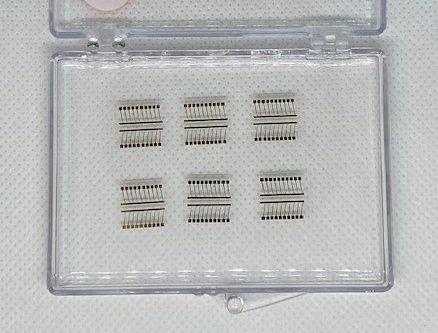
The FET 20 Electrode is a versatile Field Effect Transistor (FET) electrode designed for liquid-based solution analysis. With 20 individual electrodes, it enables high-throughput screening and parallel experiments. Its compact size (1 cm x 1 cm) allows easy integration into lab-on-a-chip devices. Ideal for bio sensing, chemical analysis, environmental monitoring, and material science. Customizable for specific research needs. A powerful tool for advancing scientific research and innovative sensing solutions.
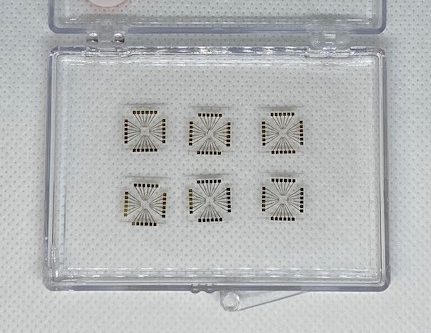
The FET 4 Electrode is a versatile Field Effect Transistor (FET) electrode with four individual electrodes, suitable for analyzing liquid-based solutions. Its compact size (1 cm x 1 cm) allows integration into lab-on-a-chip devices. Ideal for biosensing, chemical analysis, and material characterization. Customizable for specific research needs. A powerful tool for studying electrical properties and interactions in various applications.
An interdigitated electrode (IDE) is a unique electrode configuration widely employed in sensing and electrochemical applications. The term “interdigitated” describes the pattern of its electrode fingers, resembling the interlocking fingers of two hands. The IDE consists of alternating and overlapping conductive fingers, typically made of metals or metal alloys, on a substrate. This arrangement increases the electrode’s surface area, allowing for enhanced sensitivity and efficient charge transfer during electrochemical reactions.
Key characteristics of interdigitated electrodes:
- Finger Arrangement: Consist of two sets of interleaved fingers serving as working and counter electrodes.
- High Surface Area: Larger surface area enhances sensitivity and interaction with analytes.
- Reduced Resistance: Close proximity of fingers reduces lead resistance for accurate measurements.
- Applications: Used in chemical and biosensors, impedance spectroscopy, microfluidic devices, energy storage, environmental monitoring, and biomedical research.
IDEs are versatile tools enabling sensitive and efficient detection and measurement of electrical and electrochemical properties in various fields of research and technology.
Overall, interdigitated electrodes offer a versatile platform for a wide range of sensing and electrochemical applications. Their unique design, high surface area, and compatibility with microfabrication techniques make them valuable tools in research, industry, and various emerging technologies.
Interdigitated Electrode Array

The Interdigitated Electrode (IDE) Array is a highly versatile and powerful tool used for conducting a wide range of electrochemical measurements, with a particular focus on resistance and capacitance measurements in liquid samples. Its design consists of multiple sets of interleaved electrodes, creating an array format. This configuration enhances the electrode’s surface area and enables simultaneous analysis of multiple liquid samples, making it ideal for high-throughput screening and parallel experiments.
The Interdigitated Electrode (IDE) with Pad
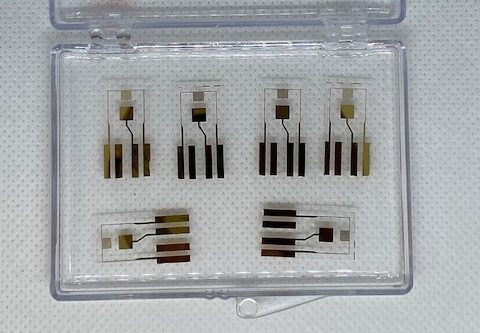
The Interdigitated Electrode (IDE) with Pad is a unique and specialized configuration of the traditional IDE, enhanced with additional features to facilitate a wide range of sensing, electrochemical, and impedance spectroscopy applications. This specialized design includes a central pad in addition to the interdigitated fingers, providing further versatility in conducting sensitive and precise measurements on liquid samples.
Interdigitated Electrode (IDE)
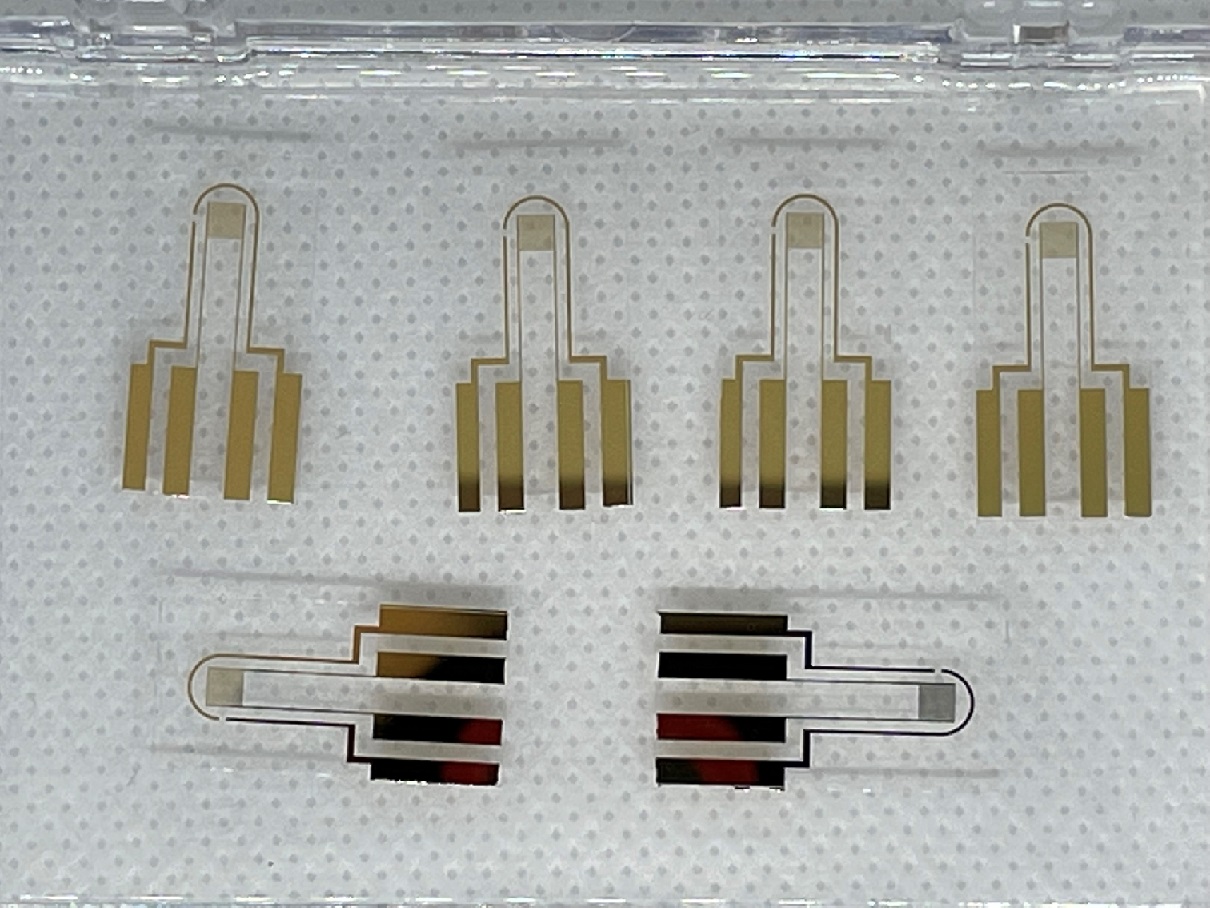
The Interdigitated Electrode (IDE) is a highly effective and versatile electrode configuration specifically designed for various sensing applications, with a strong emphasis on chemical and biosensing. The key advantage of the IDE lies in its unique arrangement, which includes both reference and auxiliary electrodes in addition to the main interdigitated fingers. This configuration allows for precise and accurate electrochemical measurements, making it a powerful tool for different types of analyses.
Padded Electrode
A “Padded Electrode” is an electrode design featuring an additional area or “pad” on its surface, serving specific functionalities or enhancing its performance in various applications. The pad is tailored to suit the requirements of electrochemical experiments, sensing, and related fields, providing researchers with a versatile tool for precise measurements and targeted interactions with liquid samples.
Padded electrodes feature a separate functionalized pad on the electrode surface, enhancing sensitivity and enabling targeted detection. Key features and applications include:
- Functionality: Pad allows functionalization with sensing materials or biomolecules for targeted detection in bio sensing applications.
- Enhanced Sensitivity: Increased surface area leads to higher sensitivity in electrochemical measurements and sensing.
- Customization: Flexible design allows tailoring to specific experimental needs.
- Electrochemical Measurements: Suitable for cyclic voltammetry, impedance spectroscopy, and chronoamperometry.
- Biosensing: Detects biomolecular interactions like antigen-antibody binding or DNA hybridization.
- Medical Diagnostics: Used in disease marker analysis and biomolecule detection.
- Lab-on-a-Chip Devices: Ideal for point-of-care testing and miniaturized analytical platforms.
Padded electrodes offer a versatile and efficient platform for various electrochemical experiments and sensing applications, benefiting research, industry, and biomedical fields.

The Multi-Pad Electrode is a versatile platform with 10 square pads (100 μm x 100 μm) for multiple sensing and analysis on a single chip. It suits protein analysis, DNA sequencing, cell-based research, and biosensor development. Spacing of 130 μm prevents cross-talk. The compact chip (1 cm x 1 cm) enables portable and high-throughput experiments. Valuable for real-time cell behavior, label-free protein analysis, drug screening, and high-sensitivity DNA sequencing. Ideal for lab-on-a-chip applications and diverse biological research.
Interdigitated Electrode with Pad

Interdigitated Electrode with Pad is a versatile platform for sensing, electrochemical, and impedance spectroscopy applications. IDE design (50 μm width/spacing) ensures high sensitivity and precise measurements. Pad functionality allows targeted detection with specific biomolecules. Compact chip (1 cm x 2 cm) enables portable experiments. Valuable for chemical and biosensing, impedance spectroscopy, and lab-on-a-chip integration. Offers flexibility and efficiency for diverse research and biomedical applications.
Probe electrodes are specialized electrodes designed for precise and localized measurements in scientific and engineering applications. Their small tips or sharp points enable access to specific locations and provide high spatial resolution data. These electrodes find widespread use in electrochemistry, neuroscience, materials science, and nanotechnology.
Probe electrodes are specialized tools with small tips or sharp points, providing high spatial resolution measurements. They find applications in various fields:
High Spatial Resolution: Probe electrodes enable localized data collection with high precision, crucial for understanding complex systems.
- Electrochemical Studies: In electrochemistry, they investigate reactions, kinetics, and behavior at interfaces with exceptional resolution.
- Scanning Probe Microscopy: Used in techniques like STM and AFM to image and manipulate surfaces at atomic and molecular scales.
- Neuroscience Research: Probe electrodes, including MEAs, record electrical signals from neurons, advancing brain function studies.
- Materials Characterization: They analyze electrical properties at the nanoscale, measuring conductivity and resistivity.
- Nanotechnology: Employed for nanomaterial manipulation and characterization, driving advancements in nanoscience.
- Electrochemical Microfabrication: Used to create precise micro and nanostructures on surfaces.
- Sensing and Biosensing: Functionalized with sensing materials or biomolecules for targeted analyte detection.
Materials and designs of probe electrodes can vary, with common choices being platinum, gold, silicon, and carbon-based materials.
Overall, probe electrodes are valuable tools, enabling localized and high-resolution measurements across diverse scientific and engineering fields, uncovering intricate phenomena and advancing research and technology.

The six-probe electrode design features an array of six working electrodes with different electrode gap distances, enhancing sensitivity and signal amplification. It enables simultaneous monitoring of multiple redox reactions, making it valuable for various electrochemical studies, sensor development, and high-throughput screening. With compact chip dimensions, it is suitable for lab-on-a-chip devices, providing a powerful platform for diverse applications in research, industry, and biomedicine.

The five-probe electrode is a specialized micro-electrode setup for measuring sheet resistance, impedance, or conductivity in diverse materials, including 2D materials, polymers, and biological tissues. Its “Kelvin method” configuration ensures accuracy by reducing lead resistance impact. With a large gap distance and versatile applications, it offers a powerful tool for materials characterization, biomedical research, and electrical property studies. The compact chip size makes it easy to integrate into experimental setups for various research and industry applications.
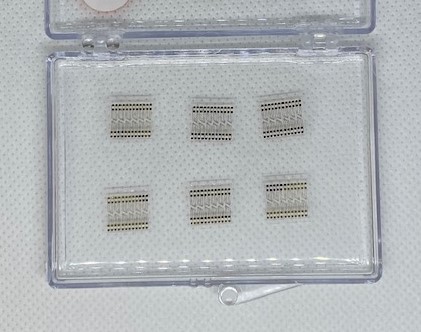
The four-probe electrode is a specialized array designed for precise testing of 2D materials like graphene and carbon nanotubes. Its unique configuration allows for accurate conductivity measurements with reduced contact resistance effects. With twelve sets of electrodes on a compact chip, it enables high-throughput testing and characterizes the electrical properties of nanoscale materials. Valuable in nanoelectronics and nanotechnology research, it offers a powerful tool for studying electronic transport phenomena and quality control in 2D material applications.
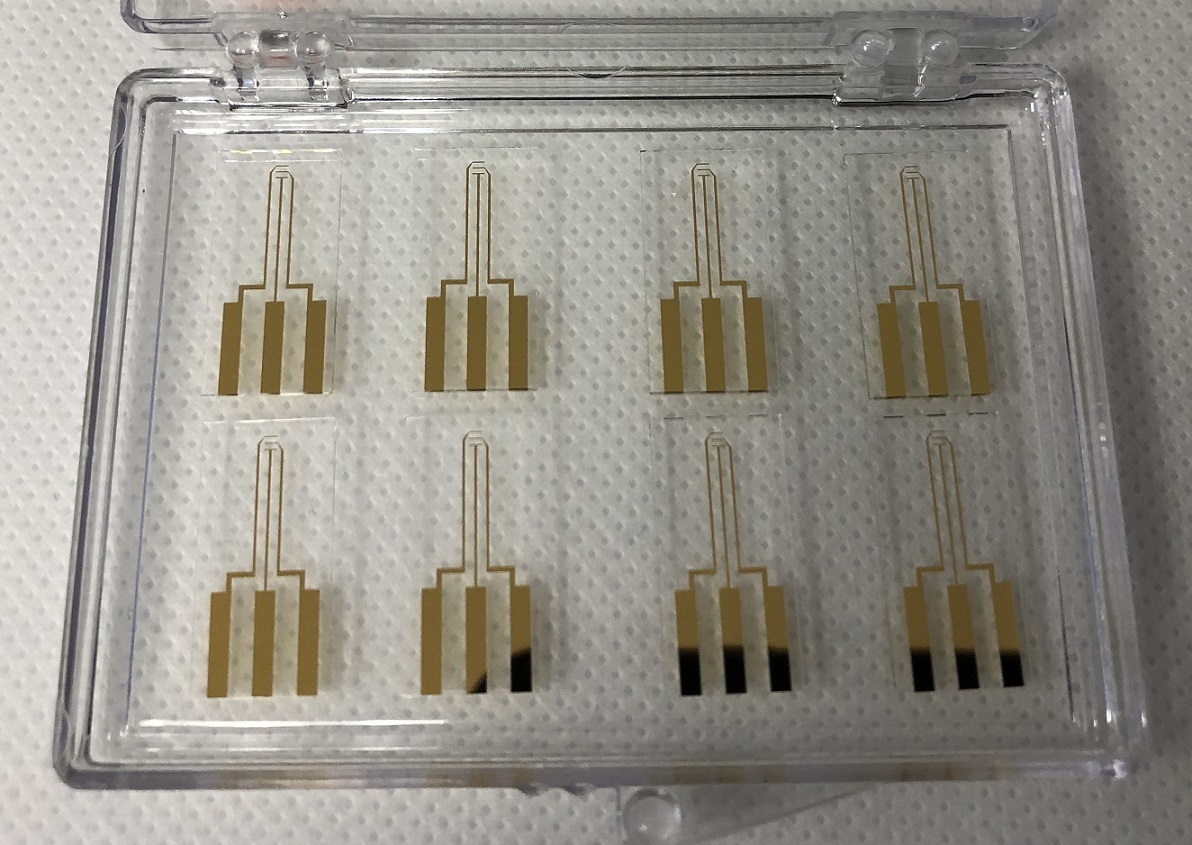
The three-probe microelectrode chip is a specialized platform for designing and testing chemical sensors and transistors. With three microelectrodes and a transparent substrate, it allows for electrical and optical sensing, making it ideal for various applications in chemical and biosensors. The gold electrodes provide high electrical conductivity for precise measurements, while its compact size enables integration into lab-on-a-chip devices for analytical and diagnostic purposes. Valuable in research and biomedical fields, it offers a powerful tool for studying chemical reactions and biomolecular interactions.
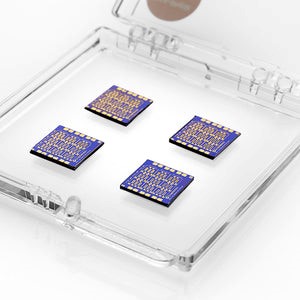
A sensing device, in the context of patterned electrodes, utilizes specialized electrode configurations to enhance performance in detecting and measuring physical, chemical, or biological properties. Patterned electrodes, with specific shapes and materials, offer improved sensitivity, selectivity, and spatial resolution, leading to better detection limits.Examples of sensing devices using patterned electrodes include chemical sensors, where functionalized electrodes detect and quantify specific analytes.
Biosensors use immobilized biomolecules to measure biological interactions. Impedance spectroscopy sensors study electrical properties across frequencies, while gas
sensors detect gases and VOCs. Environmental sensors monitor parameters like humidity and air quality. Electrochemical sensors offer precise measurements of electroactive species.
Patterned electrodes are valuable in lab-on-a-chip devices, creating microfluidic systems for rapid and miniaturized sensing applications. Their customizable patterns optimize sensing performance for different scientific, industrial, and biomedical fields, making them versatile platforms for advanced sensing technologies.
To know more about Patterned Electrodes, visit www.ultrananotec.com
 +91-8800903073, 8452810712
+91-8800903073, 8452810712
